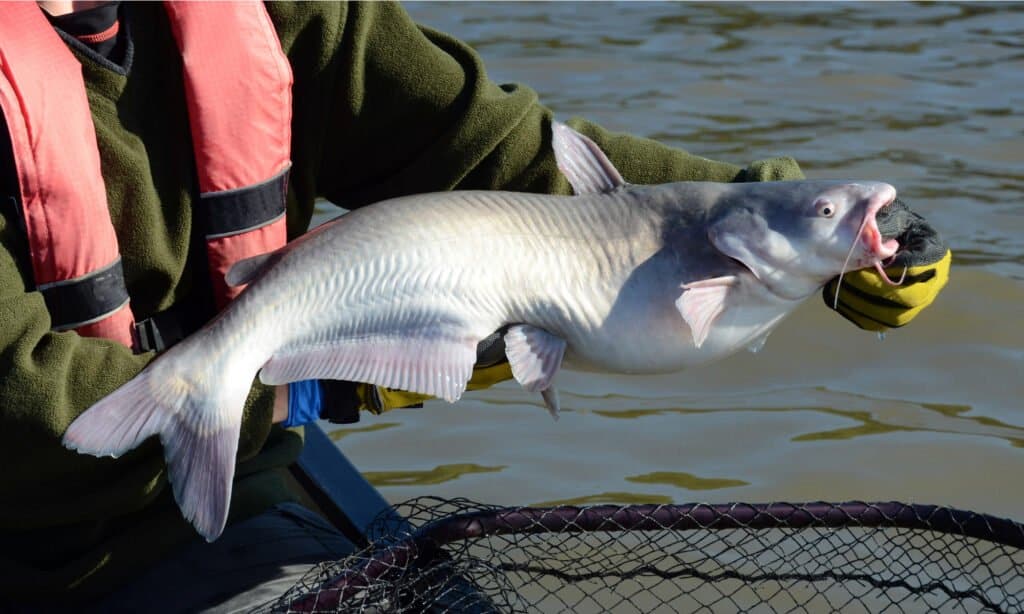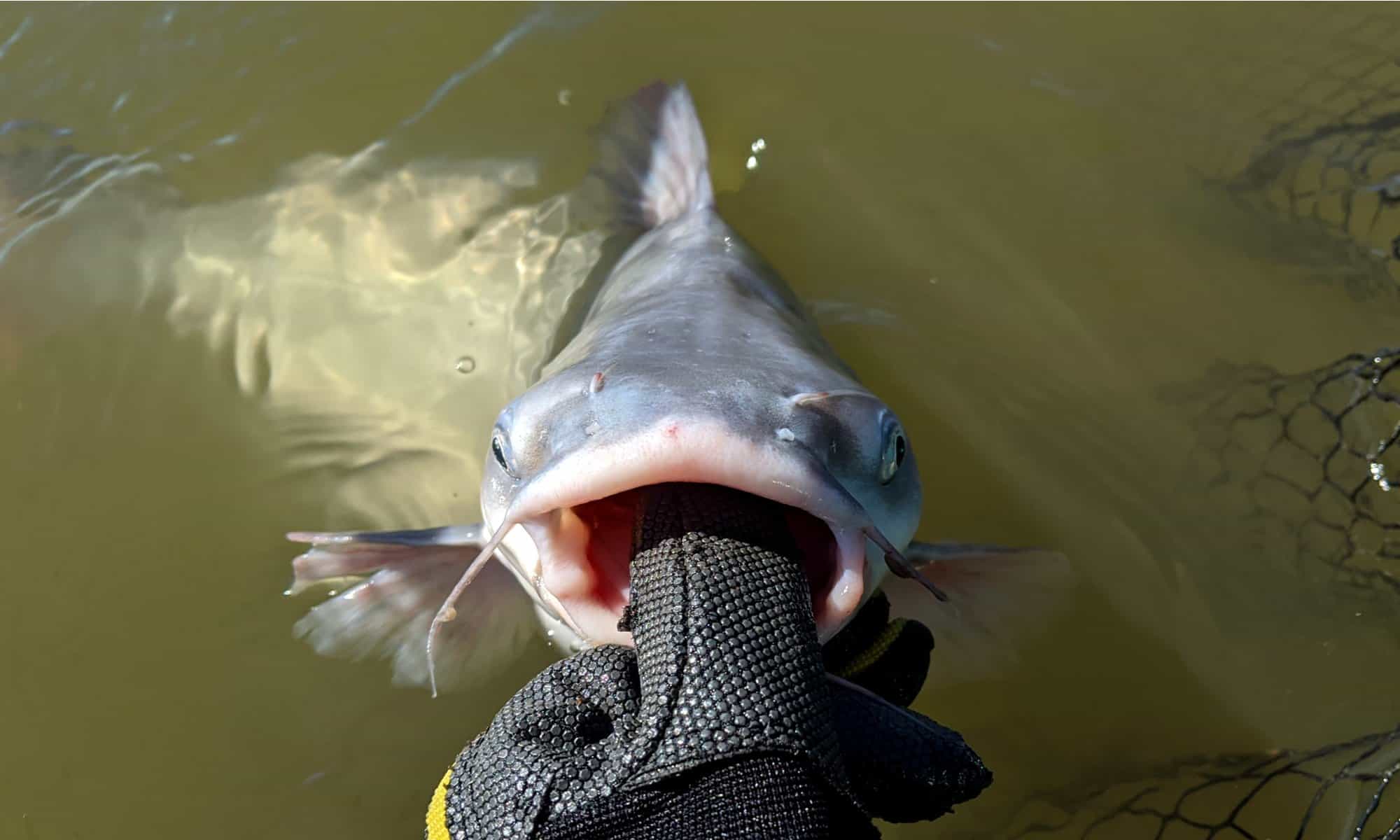2020 had its difficult moments for many but for one fisherman in Georgia, the year included a record-breaking catch. According to the Georgia Department of Natural Resources, the largest blue catfish ever caught in the state was reeled in by an angler from Florida in October 2020.
The massive blue catfish weighed 110 pounds and 6 ounces. It was a whopping 58 inches long. These fish typically weigh closer to 40 to 70 pounds as adults. The previous record in Georgia was just under 100 pounds and the 2020 record beat it by a full 17 pounds. What an amazing feat for this angler!
Blue catfish in Georgia tend to be closer to 20 pounds, although it’s not uncommon for them to reach 50 pounds or more. Blue catfish and flathead catfish are among the larger species that can be found in waterways in Georgia. Because they are large and put up a fight, many anglers like fishing for blue catfish in particular.
Where Do Blue Catfish Live?

Most catfish are bottom dwellers. They find shelter, food, and other resources in these areas. This is critical to know and understand when fishing for blue catfish. Blue catfish are named for their silvery blue color. They are native to many major rivers in the United States, including the Mississippi, Missouri, Ohio, and Rio Grande rivers. Many tributaries of these rivers also have blue catfish. Lakes and other rivers also keep blue catfish stocked in some cases.
The fisherman who caught the fish used cut bream as bait. Cut bait refers to sections of already caught fish that are cut and put on the end of your fishing line. The catfish uses its senses to get the alert that there is potential food in the area. But when they go to take a bite, the catfish are hooked onto the line and reeled in.
Because they are a popular sport fish, some areas introduce blue catfish where they might not otherwise live. This can be risky, however, and has far-reaching impacts on the environment. For example, blue catfish introduced in the Chesapeake Bay region were able to swim to other nearby rivers via the bay and expand their numbers. According to the National Oceanic and Atmospheric Administration Fisheries Department, the blue catfish in the Chesapeake Bay area feed on many of the native fish and can dominate the bottom of the waterways. Officials in these areas encourage people to fish for blue catfish to help keep the population in check.
The Best Places to Fish in Georgia

The Chattahoochee River runs through Georgia and forms the border between Alabama and Georgia as well as the border between Georgia and Florida.
©Marcus E Jones/Shutterstock.com
This giant fish was caught in the Chattahoochee River. This river is so popular for fishing that the 2020 record-breaking catch was made during a fishing tournament. The entire river covers over 400 miles and goes from the southern parts of the Appalachian Mountains through Georgia. It ends at Lake Seminole at the Georgia-Florida border.
According to Georgia’s fishing experts, the blue catfish is only one of a variety of catfish found in Georgia’s waters. Other species include channel catfish, flathead catfish, and white catfish. There are also plenty of brown, flat, snail, spotted, and yellow bullheads. They all have barbels on their faces that look like whiskers, hence the name. Catfish don’t actually have scales. Some species have scutes, which are bony coverings. Others are covered in mucous that offers some protection. Some species don’t have anything at all over their skin.
When Are These Fish Active?

This blue catfish is leucistic, which means it does not have pigment in its skin.
©Brandy McKnight/Shutterstock.com
During the day, catfish tend to stay deeper in the water, often looking for underwater caves and holes to stay in. At night, they go to shallower areas in the waterway to eat. They still stay on the bottom as they swim around and look for aquatic plants, seeds, small fish, and crustaceans. These fish like to have cover, so look for rocky areas or those with plenty of downed logs for cover. Some of the best fishing is found in these areas at dusk since the fish are emerging ready to look for a bite to eat.
It’s important when fishing for blue catfish in particular to use a heavy enough line. The line should be rated for 50 pounds and you’ll need a large hook and weights to keep the bait at the bottom of the waterway where catfish like to hang out. Using line or other gear that is too lightweight will cause it to break and the catfish to get away. While other species may be smaller or weaker, blue catfish is one of the larger species of catfish in Georgia.
Georgia Fishing Licenses

You’ll need a Georgia fishing license to fish for blue catfish and other species.
©M Huston/Shutterstock.com
If you want to fish for blue catfish or any other species in Georgia, you’ll need a state fishing license. One license includes fishing in both saltwater and freshwater in Georgia. Saltwater fishing and mountain trout fishing both have additional permit requirements. You can get an annual fishing license, which is great for those who know they will be fishing often. Single-day or consecutive-day licenses (up to 11 total days) are also available.
Visitors to the state will need to get a non-resident fishing license. There is a combined fishing and hunting option as well. The non-resident license is available for those ages 16 and over.
Young anglers under the age of 16 can get a youth fishing license, which is good up to the age of 17. Anglers over the age of 64 are eligible for a discounted senior fishing license. Both of these are slightly cheaper than the full license. Seniors can apply for an annual, short-term, or lifetime license.
Thank you for reading! Have some feedback for us? Contact the AZ Animals editorial team.








